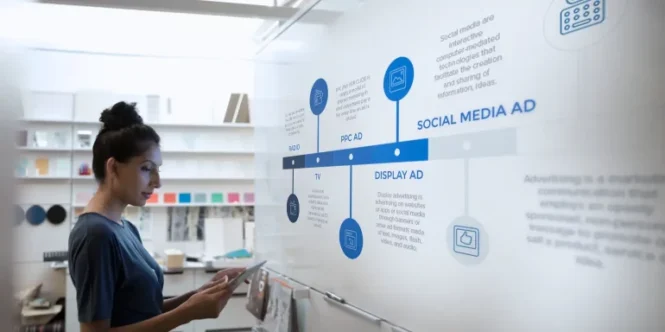The evolution of advertising over the years has been quite rapid, and now we are seeing an increasing dependence on complex analytics and even artificial intelligence. But just two decades ago, marketing lacked the support of programmatic advertising, and all the campaigns had to be developed and executed without such assets. How did things change over time, and when exactly did this transformation occur? Let’s find out!
Humble beginnings of programmatic advertising
The emergence of programmatic advertising was not a sudden change but rather a gradual evolution in the marketing industry. Initially, digital advertising was limited to static banner ads, which eventually gave way to the first-ever ad server. However, the real turning point in digital advertising came with the launch of Google AdWords, followed by Google’s AdSense as well.
What is programmatic advertising?
Programmatic advertising is a process that automates the buying and selling of ad space on websites or apps. This system utilises algorithmic software and real-time data to create an efficient platform that allows marketers to precisely target and place their ads, resulting in higher impressions and return on investment (ROI). In essence, programmatic advertising streamlines the ad placement process, making it more effective and cost and time-efficient for advertisers.
How does it work?

The main purpose of a programmatic advertising system is to create an automated link between publishers and marketers, simplifying the process of purchasing ads and managing online campaigns. Years ago, publishers were seeking ways to monetize their website inventory, and the introduction of AdSense allowed them to offer ad space on their websites.
However, this led to the creation of numerous spam websites, which were bad for business. The situation improved with Google’s Panda Update, which paved the way for the first real-time bidding and enabled programmatic advertising companies to focus more on data-driven solutions and automation. By eliminating human influence from the process, digital advertising became more effective and efficient, leading to a reduction in costs as well as rising ROI.
The main trends in programmatic advertising
As programmatic advertising continues to evolve, there are several key trends worth noting. They include:
- Contextual targeting: It’s a solution that benefits internet users because it delivers ads that are relevant to the content they are currently viewing. This approach improves the overall user experience and increases the probability of ad engagement.
- Automation: Automation in programmatic advertising provides benefits to everyone, including website owners as well as companies wanting to promote their content online. With automation, the process of ad placement and delivery gets streamlined, and the overall performance of advertising content improves.
Programmatic advertising has emerged as a potential remedy for the persistent challenge of click fraud, offering innovative solutions to address the issue.
Video advertising:

The rise of video traffic on the internet has made video advertising an increasingly popular form of content consumption. Programmatic advertising techniques can help businesses deliver targeted video ads to the right audiences, leading to more effective and efficient campaigns. When optimised correctly, video advertising can be a powerful tool for brands to engage with their target audience.
The evolution of advertising over the years has been quite rapid, and now we are seeing an increasing dependence on complex analytics and even artificial intelligence. But just two decades ago, marketing lacked the support of programmatic advertising, and all the campaigns had to be developed and executed without such assets. How did things change over time, and when exactly did this transformation occur? Let’s find out!
Humble beginnings of programmatic advertising the emergence of programmatic advertising was not a sudden change but rather a gradual evolution in the marketing industry. Initially, digital advertising was limited to static banner ads, which eventually gave way to the first-ever ad server. However, the real turning point in digital advertising came with the launch of Google AdWords, followed by Google’s AdSense as well.
The evolution of advertising has seen remarkable progress, with programmatic advertising playing a significant role in transforming the industry. Initially limited to static banner ads, the introduction of ad servers and Google AdWords marked key milestones. The rise of the internet and display advertising provided global reach, while search engine advertising revolutionized online marketing with real-time tracking. Social media platforms further enhanced targeting and engagement. However, programmatic advertising has taken advertising to new heights. Powered by AI and data-driven algorithms, it automates ad buying and selling in real-time, delivering precise targeting and personalized messages. With ongoing technological advancements, advertising will continue to adapt to meet consumer preferences.

One significant milestone in the evolution of advertising was the rise of the internet. With the advent of the World Wide Web, advertisers gained access to a vast global audience and new advertising opportunities. Display advertising became prevalent, allowing brands to showcase their products and services through visually appealing banner ads on websites.
As internet usage grew, search engine advertising emerged as a powerful tool. Google’s introduction of AdWords revolutionized online advertising by enabling businesses to bid on relevant keywords and display their ads alongside search results. This pay-per-click model provided a more cost-effective approach and allowed advertisers to track the performance of their campaigns in real-time.
Social media platforms further transformed the advertising landscape. With platforms like Facebook, Instagram, and Twitter, advertisers gained access to highly targeted audiences based on demographics, interests, and behaviors. The ability to engage directly with users through interactive content and influencer partnerships has become a key strategy for many brands.
Conclusion
In recent years, the rise of programmatic advertising has taken advertising to new heights. Programmatic advertising leverages artificial intelligence and data-driven algorithms to automate the buying and selling of ad space in real-time. This technology enables advertisers to reach their target audience with precision and efficiency, optimizing ad placements and delivering personalized messages at scale.
Overall, the evolution of advertising has been marked by technological advancements, data-driven insights, and the need for more personalized and relevant experiences. As technology continues to advance, we can expect advertising to further evolve and adapt to meet the changing needs and preferences of consumers.
 Imagup General Magazine 2024
Imagup General Magazine 2024



